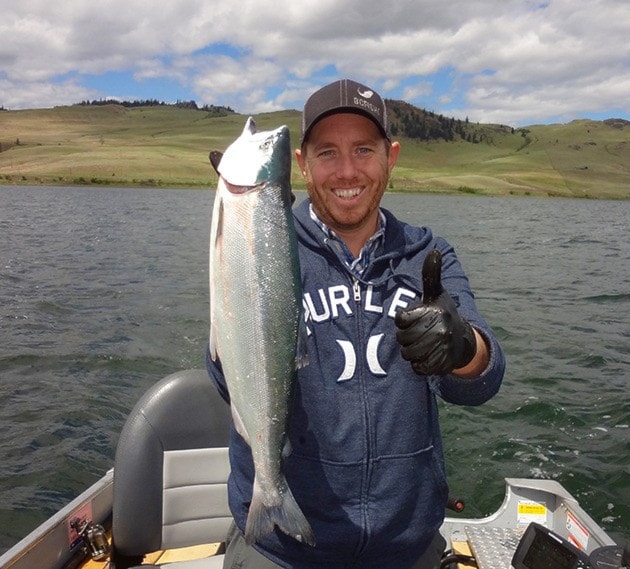Kokanee and freshwater sockeye salmon fishing are quickly becoming one of the most popular sought out fisheries in the Pacific Northwest. Kokanee are second only to rainbow trout as the most popular game fish in B.C and Wood Lake continues to provide a great sport fishing opportunity for kokanee. Now with the return of the Columbia-Okanagan River sockeye salmon, there are sport fishing opportunities like no other in the Okanagan.
The popularity of these fisheries can create some challenges however. Some anglers prefer to harvest a limit of the larger sized fish, while releasing the smaller, more abundant kokanee in the process. Others will catch and release fish once their daily limit has been reached in order to continue fishing. This leads to the question: Does releasing kokanee and sockeye increase mortality rates?
91������Ƶ�T��� warmer summer months, known as the danger months, are a good time for anglers to strongly consider stopping catch and release kokanee fishing due to increased ���ǰ��ٲ������ٲ�,91������Ƶ� said Okanagan fisheries biologist Jason Webster from Chara Consulting.
As summer water temperatures climb to 21 C, catch and release mortality rates for kokanee and salmon species increases. Kokanee and sockeye commonly move deeper in the water column in July and August, seeking out cooler water temps in the 5 to 10 C range.
����91������Ƶ�s not uncommon to catch kokanee or sockeye in 60 to 90 feet of water during the summer months. This means a hooked kokanee or sockeye may ascend through a 20-plus degree temperature change in a short period of time which is extremely stressful to the fish and even deadly. Most kokanee simply ��Dz�91������Ƶ�t have the energy needed to swim back down to the cold depths in which they came from. Even though the fish may swim away appearing to be unharmed, there is still a chance that it ��DZ����91������Ƶ�t fully recover.
91������Ƶ�T���DZ������Բ� with downriggers can be a very effective method to catch fish on large lakes in summer ���DzԳٳ��,91������Ƶ� explained Freshwater Fisheries Society of BC scientist Dr. Paul Askey. 91������Ƶ�T��� reason why downriggers are so effective is that fish are forced to congregate at specific depths in the water column where they can find temperatures that meet their thermal tolerance limits. However, for this same reason, fish are put under a lot of stress when they are hooked and reeled to the warm surface water. This is not an appropriate method to practice catch-and-release because we expect a high portion of released fish will die. Basically anglers should view summer downrigger trolling as a catch and kill method of �ھ����Բ�.91������Ƶ�
Rick Simpson from the BC Wildlife Federation inland fisheries committee added:
91������Ƶ�T����dzܲ��� my hands-on experience kokanee and sockeye can easily die when released in high water temperature conditions. ����91������Ƶ�s better to be safe and keep the fish as part of your daily limit. Let the fish dictate on what size your limit will be for the �岹��,91������Ƶ� said Simpson.
In the cooler months such as early spring, kokanee are found closer to the surface because the water temperatures are much cooler. At this time, even though ����91������Ƶ�s not recommended, releasing a kokanee would probably result in a more positive outcome. If an angler chooses to catch and releasekKokanee there are some preventative steps to take to decrease mortality.
91������Ƶ� Use single hooks on lures and bend down the barb for easy release.
91������Ƶ� Minimize the fight time. Tired and stressed fish have higher mortality rates.
91������Ƶ� Minimize handling, which can cause scale loss and later infection. If you must handle a fish, wet your hands first.
91������Ƶ� Use rubber or coated nylon nets which will reduce injury to the �ھ�����91������Ƶ�s slime layer and fins and tangling with hooks.
91������Ƶ� Quickly remove hooks with forceps or needle-nosed pliers. Netted fish can remain submerged in the water while removing hooks. Many fish, especially small ones, can easily be released in the water without netting or handling them.
91������Ƶ� Minimize time exposed to air, especially when the weather is warm. A fish held out of the water is suffocating.
91������Ƶ� Allow netted fish to recover while in the net along the side of the boat (or shore) before releasing.
91������Ƶ� If the fish is bleeding from the gills or was exhausted from the fight, ����91������Ƶ�s unlikely it will survive after release.
For more information e-mail Danny Coyne at danny@bcfishn.com



